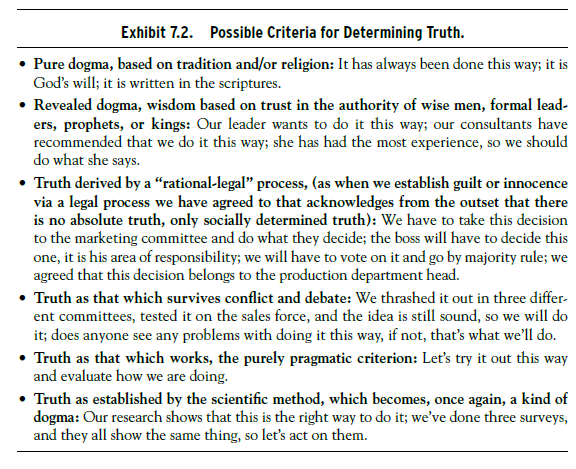A useful dimension for comparing groups on their approach to reality testing is an adaptation of England’s (1975) moralism-pragmatism dimension. In his study of managerial values, England found that managers in different countries tended to be either pragmatic, seeking validation in their own experience, or moralistic, seeking validation in a general philosophy, moral system, or tradition. For example, he found that Europeans tended to be more moralistic, whereas Americans tended to be more pragmatic. If we apply this dimension to the basic underlying assumptions that a group makes, we can specify different bases for defining what is true, as shown in Exhibit 7.2.
This dimension not only highlights the basis on which truth is determined but also can be related to “uncertainty avoidance,” a major dimension found in Hofstede’s survey-based cross-national study, and to “tolerance for ambiguity,” an important dimension that came out of post-World War II research (Hofstede, 2001; Adorno and others, 1950). Managers and employees in different countries and in different companies vary in the degree to which they share a certain level of comfort with varying degrees of uncertainty and ambiguity. As environments become more turbulent and occupations become more technically complex, the ability of leaders to tolerate uncertainty will become more necessary for survival and learning, suggesting that organizational and national cultures that can embrace uncertainty more easily will be inherently more adaptive (Michael, 1985).
This discussion can be summarized best by showing how it applies to our two cases. DEC had both high consensus that reality was defined by pragmatic criteria and debate and a very high tolerance for ambiguity. In my consultation work with DEC, for instance, I was never asked for a recommendation. If I gave one, it was usually overridden immediately by various ideas from the client, which were then debated among the members. In Ciba-Geigy, I was always treated as an authority and asked what I knew from my research and other consulting experience and what I would recommend. I was treated as a scientist who was bringing knowledge to the organization, and I often found that my recommendations were implemented in a very precise manner. If what I recommended conflicted with other cultural elements, for example, when I suggested more lateral communication, the recommendation was dismissed outright. Ciba-Geigy did not tolerate ambiguity well and operated much closer to the moralistic end of the dimension.

Source: Schein Edgar H. (2010), Organizational Culture and Leadership, Jossey-Bass; 4th edition.

I am impressed with this site, real I am a big fan .
Keep up the great work, I read few articles on this web site and I believe that your web site is rattling interesting and holds circles of good info .